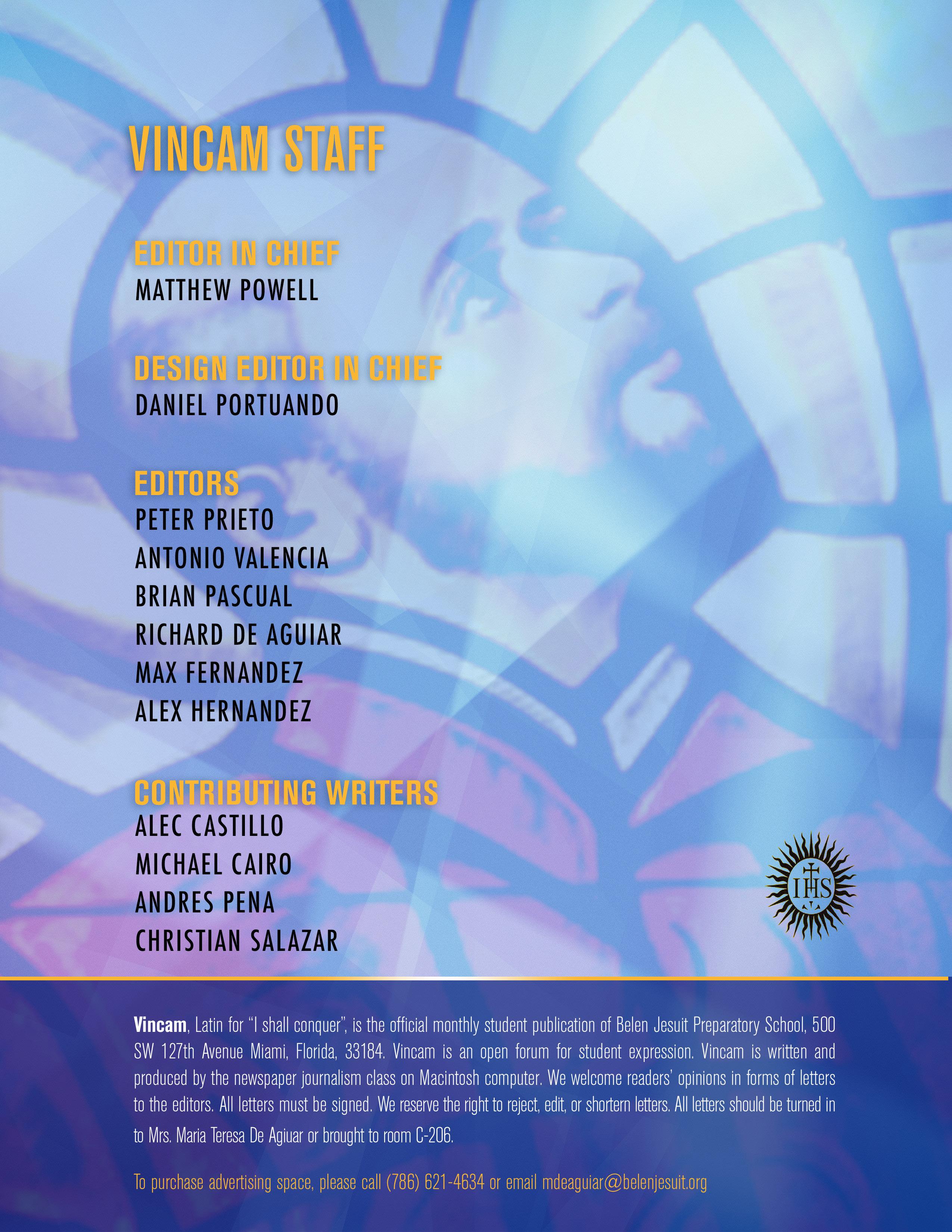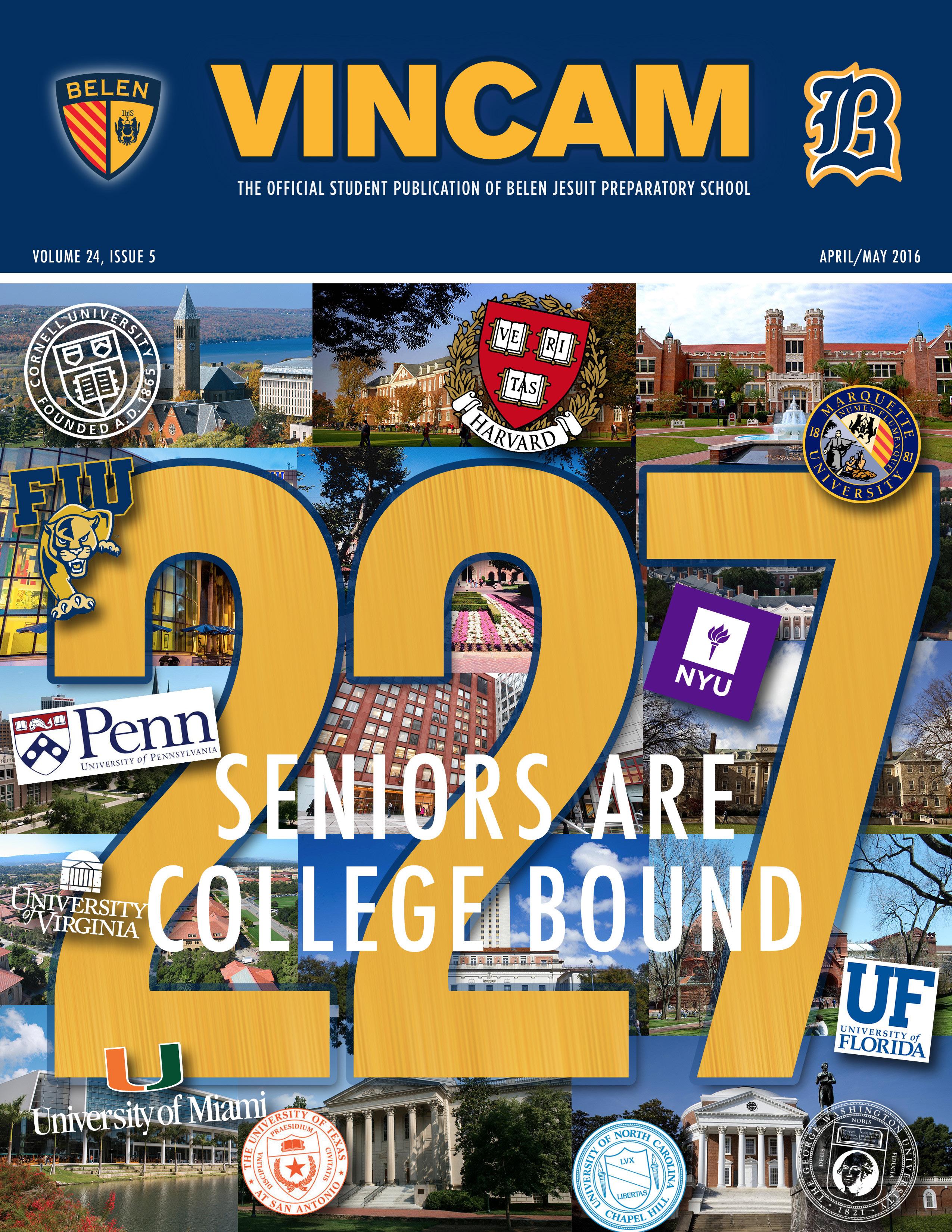
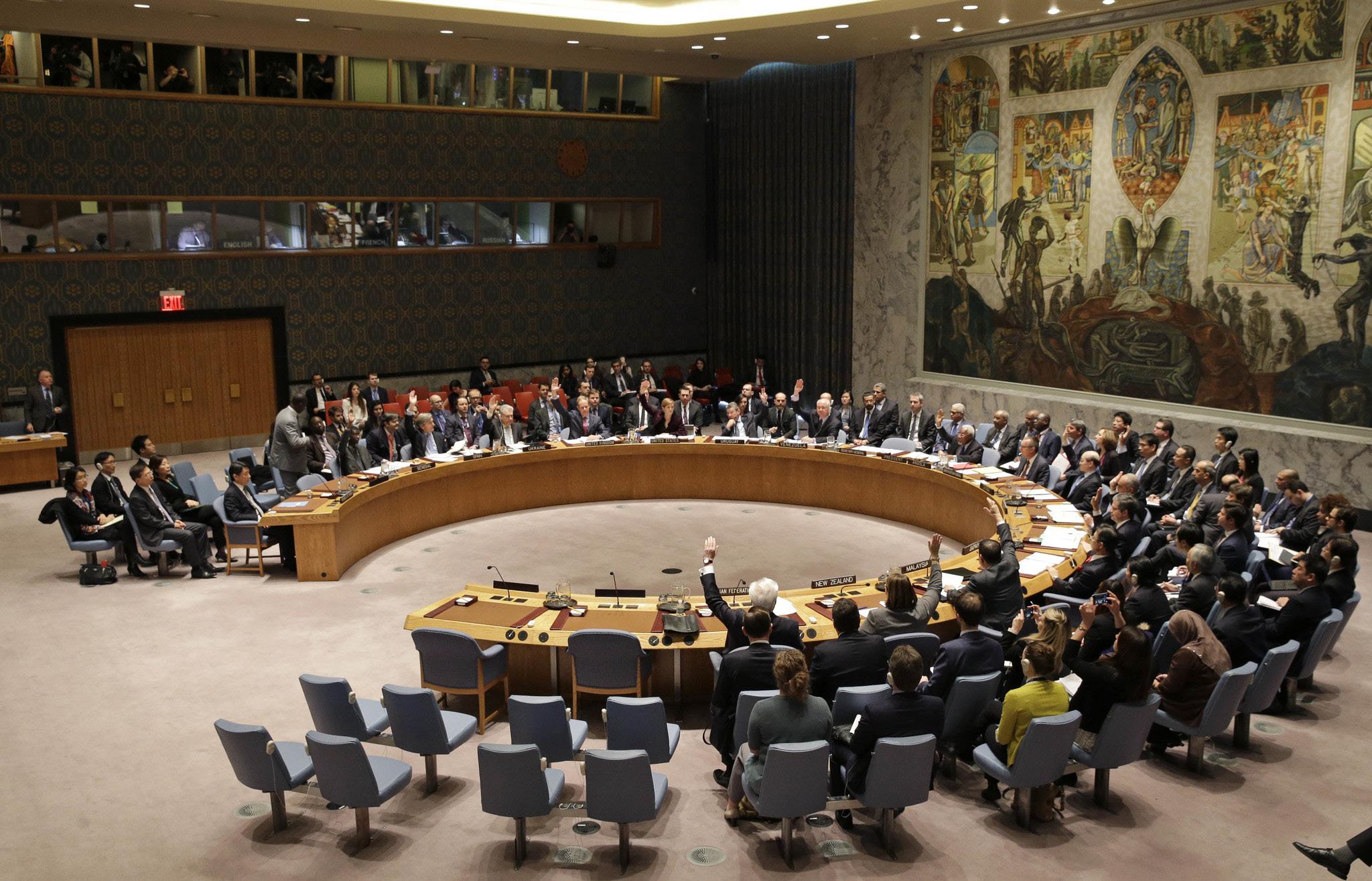





By: Daniel Portuondo
North Korea’s rebellious nature has instigated the United Nations (UN) to place stricter sanctions on the nation. Despite any restrictions previously instated on its nuclear weapons programs, the country, under the leadership of Kim Jong-un, has continued to experiment with nuclear power, with the latest taking place this past January, and even a rocket launching earlier in February. As a result, the UN Security Council unanimously voted in March to take action against North Korea’s unruly undertakings. Currently, these sanctions remain in effect.
The most prevalent of these sanctions is the severe policing of North Korean trade. Any and all cargo leaving from or headed to North Korea must be inspected; whereas previously, inspection was only necessary when contraband was suspected. This includes the trade of weaponry and luxury goods such as luxury watches, recreational aquatic vehicles, and snowmobiles. Though this may seem rather irrele-
vant to the issue at hand, Kim Jongun often uses these trade items to reward his officials and assure their loyalty. Several trade ambassadors, companies, and government agencies have been blacklisted to further inhibit the country’s belligerent measures. Among these are trade representatives from Vietnam, Syria, and Iran. In total, 17 North Korean individuals and 12 North Korean entities would have to adhere to restrictions. However, North Korea still has the power to engage in oil, coal, and iron trade, as long as it doesn’t contribute to their nuclear weapons program. Evidently, for such an authoritarian nation, this factor may be rather hard to prove.
Additionally for North Korea, diplomatic immunity no longer applies. Countries are required to expel diplomats of the nations, should they engage in any illicit activities. Nor can North Korea send martial arts experts to train the police forces of other countries, an act which was recently brought to light in Uganda. U.S. Ambassador to
the UN, Samantha Power, has also highlighted that financial sanctions would target the country’s banks and the supply of aviation fuel would be prohibited.
She assured that these restrictions were by no means meant to be aimed at the North Korean populace who “have suffered so much already,” but rather at the “ruling elite that have inflicted so much of that suffering.” Power believes that North Korea’s “resources are channeled into its reckless and relentless pursuit of weapons of mass destruction.” The following morning, North Korea responded with blatant defiance. South Korea detected several short-range projectiles were launched into the sea.
“I really hope that the United Nations holds its ground and continues to enforce its sanctions on North Korea. It may not be enough, but at least it’s a start,” said junior Christopher Avallone.







Ablood-born disease has made big trouble this year in Latin America, and it is finding its way to American waters. The Zika virus is a flu-like illness that spreads through the Aedes mosquito, a common species in South and Central America. The illness itself is not particularly harmful to adults, causing only minor, flu-like symptoms. The real harm of disease, however, is in pregnant women, more specifically, their unborn children. Zika is being linked to increased cases of microcephaly, a defect that causes unborn children to develop a smaller skull, causing impaired brain development and cognitive ability.
The virus has been in circulation in equatorial areas since the 1950s, but only now has it reached large population areas in Central and South America. The disease is considered uncurable and impossible to prevent through vaccination. As a result, the disease has spread fast in tropical areas, and according to the Center for Disease Control (CDC), it has reached pandemic levels. Zika virus is spread primarily through mosquitos, although some evidence indicates the possibility of sexual transmission as well. The virus causes flu-like symptoms, in addition to a rash, but it is generally not deadly to adults and treatable with rest. For
children, however, the disease can cause complications, and for unborn children, the virus may cause serious defects.
Although not totally proven, it was this past February that the connection between Zika and Microcephaly began to emerge. Scientists have begun to delve into the virology of Zika to deteterime whether or not the virus is the cause of the increased rates of Microcephaly. The virus has thrown countries like Brazil and Argentina, who have high populations of the Aedes mosquito, into pandemic. The governments of these countries are warning pregnant women to avoid going outside without protection, and some countries are even advising women to avoid getting pregnant altogether. Amidst rising infection rates in South and Central America, as well as the Caribbean, it is important to realize that Zika can soon be a major US problem as well. “Zika is something, that considering where Brazil is on the world stage, isn’t just a problem for Brazil, but for the whole world.” Said Latin American teacher Dr. John Gustavsen.
Due to the virus vector being mosquitos, there is an imminent threat of Zika arriving in the US. The CDC has already advised against traveling to countries where the virus
is spreading at a rapid pace. Multiple cases have already been reported in the US, but these cases are far and few, and all due to travel-related instances. The closest cases of mosquito-acquired Zika have occurred right at the door to the US, as the virus has already began to spread rapidly throughout the Carribean. Puerto Rico alone has had over 100 cases reported already, and it is for this reason that the CDC fears that Puerto Rico will serve as the ground zero for Zika in the States.
Until a vaccine or cure can be developed, there is no sure-fire way to combat or prevent the virus. So far, the only real ways to prevent the spread are methods that combat the mosquito themeselves. Naturally, it is impossible to kill or avoid every mosquito, so the bleak outlook is that Zika will make its way to the US in the coming months.
“Hopefully, we can put it off by killing mosquitos, but the virus will probably come here,”said senior Kevin Gonzales.
As for Central and South America, as well as the Carribean, Zika will continue to infect people and cause major birth defects in the unborn children of the women infected.

By: Alex Hernandez
The discovery of gravitational waves will be monumental in the establishment of new branches of science.
By: Peter Prieto
In 1916, Einstein changed physics, noting that space and time are not two separate entities. One hundred years later, and from his grave, he is responsible for yet another monumental change in physics. On September 14, 2015, scientists at the Laser Interferometer Gravitational-Wave Observatory (LIGO) began doing what they were meant to do: observe space for proof of gravitational waves. That day, they received a signal from the merging of two black holes. Less than six months later, LIGO confirmed that they had observed gravitational waves.
LIGO had a rough start early on in the idea since process funding was cut several times. About 20 years ago, after decades of issues with funding, they broke ground. There were hundreds of millions of dollars poured into something meant to prove a genius - who was long dead at this point - correct in his theo-
rizing. Without the ambition of the scientists involved, science would not have the findings it has today. What they observed came from two black holes merging. The black holes in question did not just merge overnight; it happened nearly a billion years ago. As they traveled through space, Earth ran its course, from the earliest of life to the advanced civilizations we live in and study today. Any object that moves through space-time causes gravitational waves, which dissipate quickly. Even with something as massive as black holes, the waves are difficult to catch. In 2014, scientists thought they observed gravitational waves left over from the Big Bang. No doubt excited, these scientists had to review their findings, and they realized that their findings had been triggered by dust in the Milky Way. Gravitational waves prove Einstein’s general theory of relativity. This theory states that objects cause
space and time to curve around the object.
“Breakthroughs like this happen every now and then. When it comes to this field, we have to wait for them, and when they come, they’re monumental,” said senior Michael Cairo.
Even Einstein, at times, went back on his theory. He flip-flopped on the idea of gravitational waves and their existence. Scientists have only theorized their existence up to this point.
Recent news will surely be analyzed and studied. This could potentially lead to big changes in the scientific community. Among new branches in astronomy coming out of it, physicists can see details of the universe like never before. Some suggest these gravitional waves could help scientists figure out what the universe is made of. Yet, only time will tell, since these waves are extremely difficult to come across.

By: Alex Hernandez
Billionaire genius, Bill Gates, is on the cusp of creating clean and efficient energy that could “save the earth.” Gates envisions a world where he could provide clean power without the use of electricity.
His goal, as expressed in a 2010 TED talk, is to allow humanity to reach zero global carbon emissions in the next 35 years. This is a goal that will require huge advances in nuclear, solar, and wind power.
“Right now, the world spends only a few billion dollars a year on researching early-stage ideas for zero-carbon energy. It should be investing two or three times that much,” said Gates recently.
Since late 2015, Gates initiated Mission Innovation, a commitment by more than ten countries to invest more in research on clean energy. The countries invested in this mission pledge to double their government resources
to clean energy. Gates and other billionaires, such as Mark Zuckerberg, invested into clean energy. The Breakthrough Energy Coalition is a massive group of billionaires who invest and help those countries that are committed to having clean energy.
The project invests billions of dollars into research for clean energy. Gates plans to invest $1 billion in clean energy companies over the next five years. The other billionaires and members of the coalition are expected to invest at least a combined $1 billion over that same time period.
“It would be amazing to have a clean energy resource that doesn’t hurt the earth. It would be a tough task, yes, but ultimatley it’s a good investment,” said junior Luca Pola.
Is clean energy even possible? Well, according to private companies and scientists, this may be within the near future. The government, private companies,
and investors are consistently pushing for this idea to become reality. The goal is to stop air pollution, considering that all the factories in the world pollute the earth with carbon everyday. With the use of wind turbines, hydropower dams, solar energy, and thermal energy, the world is looking for a cleaner future.
Bill Gates envisions that in 15 years, the world will solve its energy crisis. Gates is currently happy with the current technologies of clean energy, but he expresses that the necessity for new technology must be a priority. Wind and solar energy alone won’t eliminate the world’s pollution problem, but instead, we need to come up with even more innovate ideas.
“It’s very interesting to see some new ideas and technologies that have been created to save our earth. I’m very intrigued to see what comes next,” said senior Andres Cesin.

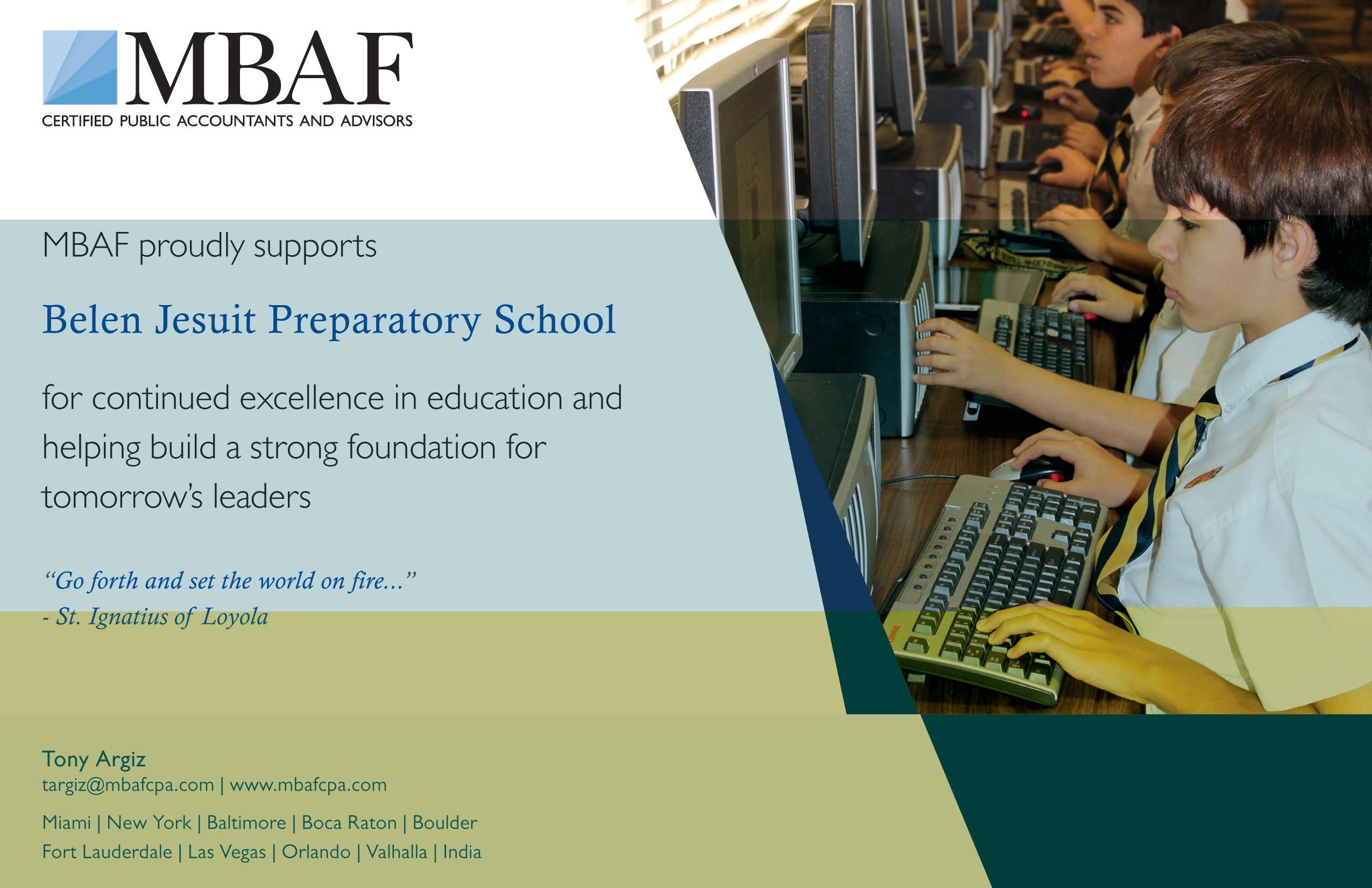

By: Brian Pascual
The 2016 Miami Marlins season, so far, has been a rather interesting one. Last season, the team struggled throughout the entire year and finished twenty games below .500. The team finished with a record of 71 wins and 91 losses.
“Last year’s season was very frustrating to watch. There was much promise at the beginning of the season, but it all went downhill from there. The team showed signs of inconsistency throughout the whole year,” said senior Alexander Falla.
One major reason was the loss of Giancarlo Stanton, who was plagued by injury. Stanton was out for around two months, leaving the Marlins without their star player and an exponential decrease in the production of the offense. Starting pitcher and former all star Jose Fernandez was also out all of last year due to Tommy John Sugery. After last year’s mediocre season, the
Marlins’ front office fired manager Mike Redmond and bench coach Tom Leary.
This year, the Marlins are looking to make a run for the playoffs, by recently hiring former Los Angeles Dodgers manager Don Mattingly, who led the Dodgers to three straight post-season appearances. He looks to bring a winning attitude to the clubhouse.
“I think that the hiring of Mattingly will bring success. It is finally great to see a manager who has won in the past take control of this young and talented team,” said season ticket holder Daniel Hondal.
The Marlins will have to compete in a tough National League East division. The New York Mets and Washington Nationals all pose as threats to the Marlins, who have a young but impressive pitching staff this year. With the resigning of gold glover second baseman Dee Gordon, the
team is looking to keep up their solid defense. The squad also resigned future hall-of-famer Ichiro Suzuki. This year, the team is looking towards all stars Giancarlo Stanton and Jose Fernandez. Stanton was on pace for an MVP season last year, but he was injured. The Miami Marlins are also considered to have one of the best outfields in Major League Baseball. Christian Yelich and Marcell Ozuna will accompany Stanton in the outfield. Many Marlins fans, will be watching to see if the Marlins can turn around their twelve-year drought of not making the post season. This has caused many fans to not attend the home games and many to question whether the new stadium was worth the cost. Yet now, with the acquisition of a new manager and very talented players, the team is having a successful year. Could the Marlins be looking at a run for the World Series in the future?

By: Alex Hernandez
The Miami Heat had been on fire since the all-star break. They may have ultimately lost the eastern conference title to the Toronto Raptors, but nontheless, their succesful season and bright future cannot be discounted. During this season, Pat Riley executed more genius moves in trading for more cap room and picking up seven-time all star Joe Johnson. The Heat evolved from averaging the second-fewest points (96.0) in the league before the All-Star break, to becoming the fifth-highest scoring team (107.4) in the league. The Heat finished 19-10 after the all-star break. In those 29 games, the Heat showed much promise from their team even without all star Chris Bosh. The Heat’s rookies, Justice Winslow and Josh Richardson, majorly contributed to the team, and the results have proven themselves.
The Heat went from a third worst in the league to third best in three-point shooting percentage. They also had more possessions and
controlled the tempo in their games. Josh Richardson broke a record for sustaining over 60 percent from the three-point line. Heat coach, Erik Spoelstra, became creative in the way he used Hassan Whiteside. Hassan is arguably one of the best, if not the best center in the league, averaging 14 points, 12 rebounds, and a league high 3.7 blocks per game. Hassan’s game evolved tremendously from becoming a bigger presence on offense and free throw shooting. Hassan finished second in defensive player of the year voting only to San Antonio’s Kawhi Leonard. Spoelstra made the bold move in moving Hassan to the bench and starting Amar’e Stoudemire at the center position. The move surprisingly paid off, with Hassan putting up big numbers coming off the bench. This surged the Heat into the third seed of the eastern conference.
“Hassan Whiteside is a beast! A seven-footer that is an all around star is hard to come by, and the Miami Heat have a very spe-
cial player. I go to Heat games and expect Hassan to energize the crowd with his emphatic blocks and his forceful dunks,” said senior Johnny Hyland.
The Heat finished the season 48-34, and with the third seed in the eastern conference. They played the Charlotte Hornets in the first round of the playoffs. That first playoff game was an exclamation point for the Heat, as they controlled the game from the start, scoring 41 points in the first quarter. The Heat never let off the gas and routed the Hornets 123-91. Loul Deng had a monster performance with 31 points on 11-13 shooting. The Heat easily moved on to the semi-finals and faced the Toronto Raptors. Overall, they had better games, but they were unable to stop the Raptors’ force.
“The Heat hadn’t been this good since Lebron left. We had a legitimate shot at making and winning the title, and that’s what counts. I can’t wait for next season,” said senior Andres Cesin.
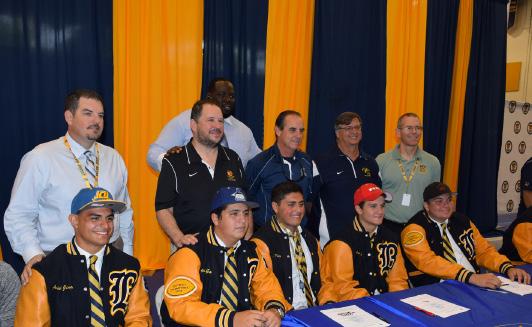
By: Max Fernandez
The Class of 2016 excelled in athletics throughout their high school years.
During this 2015-1016 school year, they have won district titles in football, soccer, lacrosse, baseball, cross country, track, golf, bowling, and water polo. Some of these sports have even won districts for the last two seasons, like the varsity football team. Water polo went 27 and 0, losing to no one and beating everyone, and clinched its second state title in a row. This water polo team will be remembered like the 1972 Dolphins team... Perfection.
“I was never really big on water polo, and I actually had never seen a water polo game until Belen’s team made it to states. But, I have a newfound respect for the sport, and I love watching our team dominate,” said junior Peter Martin.
The varsity soccer team
did not lose a game this season and won a state title. They had the biggest turnout of fans out of any other school at the state game in Marco Island. The team definitely had a great soccer player in senior Frankie de la Camara, who could possibly be the best player to ever play for Belen. He was a few goals short of the state record, with over 55 goals, and he also won Mr. State, which is given to the best player in Florida.
“Frankie is the best player I have ever seen play soccer. Every time I went to see a game, I knew he was guaranteed two or three goals,” said senior Johnny Mac Hyland.
The varsity cross country team finished fourth in states, both the track and baseball teams had a solid end of season, and our crew team is competing on a national and international level. Additionally, over 20
school athletes have committed to taking their talents to the collegiate level next fall. These Class of 2016 student-athletes signed letters of intent that include eight football players, five lacrosse, three baseball, five rowers, and two soccer athletes who will all compete at the college level.
“I decided to take my talents to the collegiate level because Belen prepared me for it. Coach Stuart made my dream a reality, and I owe all my talents to his wonderful coaching,” said senior Andres Cesin.
The Class of 2016’s varsity athletes have accomplished a great deal: a district championship in almost every sport, two state championships, and a national crew championship. They will be remembered for many great things, but athletics will stand out above the rest.




By: Matthew Powell
Having known Mr. Roca as a basketball coach from a fan’s perspective, and as a teacher from a student’s perspective, it is sad to see him step down as varsity basketball coach. Mr. Jose Roca has served as a basketball coach at Belen Jesuit for 28 years, at all different levels. His most recent endeavor consisted of coaching the varsity basketball team, leading the program to ten regional playoff appearances. Mr. Roca is an excellent representation of the kind of man Belen Jesuit likes to be associated with, devoting his work to this school and to the basketball program for so many years, and with tremendous success.
“Belen takes great pride in its athletic program,” said Jesuit Father Guillermo “Willie” GarcíaTuñón, school president. “The extraordinary success that we have enjoyed over the years is more impressive when you consider that Belen is committed to raising its student-athletes throughout their years in middle school and high school. We win with what we have and with what we coach. José Roca
has tirelessly built a program that nurtures athletic and academic talent from the moment the boys step on to the campus in middle school. For this, we will be eternally grateful to him.”
It was an honor to watch Mr. Roca’s basketball teams since my sixth grade year, and it was even more of an honor to have him as a math teacher for two consecutive years. His legacy at Belen in both settings speaks for itself.
“Coach Roca’s legacy will always be imprinted in this institution, and playing under that legacy was truly a blessing. The school and players will definitely miss Coach Roca, but the program’s bright future is something to look forward to,” said senior guard AJ Consuegra, when asked about how it felt to play his last year with Mr. Roca.
The Vincam staff wishes Mr. Roca nothing but the best as he begins a new chapter in his career as Principal of Belen Jesuit.
Father Willie announced the hiring of Gaston “Chachi” Rodriguez as Mr. Roca’s replacement. Coach Rodriguez’s resume speaks
great volumes about his ability and success at the high school level. Being the only coach who has won state championships at two different schools in Florida, Coach Rodriguez brings championship experience to the basketball program. Rodirguez’s championships came in 2000 at Hialeah Champagnat Catholic and in 2009 at Coral Reef High School. Belen, who has never been to a state championship game in basketball, will be able to utilize Coach Rodriguez’s know how and experience to have the team move past the regional rounds and into the state final four.”
Rodriguez has been the coach at Coral Gables for the past three years, where he led the team to a district championship this past year. He is a graduate of St. Brendan High School and has a son at Belen Jesuit. The school, as a whole, looks forward to seeing what Coach Rodriguez will do in the coming years, as we wish him great success.

By: Matthew Powell
Water polo is a sport that does not warrant a lot of attention at Belen, at least during the regular season. That’s because the team and program is nothing short of dominant, boasting 50 wins in their last 51 matches. The most important part of their season comes in the spring during the playoffs, which is when the hype usually begins to surround the team.
The team’s first big test comes against Ransom Everglades High School, the host of the district, regionals, and state tournaments. The winner of this game has usually gone on to the state finals in the past, so the matchup brings a lot of attention. The Wolverines earned their way to an 8-6 victory, thus capturing the district championship.
The team then cruised to the state semifinal, with wins against Gulliver and Mourning, winning by a combined 24 goals. The win against Mourning set up a semifinal matchup against St. Andrews, a team that Belen Jesuit has history with in terms of water polo. The two teams faced
off twice in the regular season, with the Wolverines winning both games by the score of 9-7. This semifinal matchup resembled the first two games in a lot of ways, going back and forth to the very end with slim separation between both squads. This one came down to the final seconds, with Pablo Kurzan scoring with 31 seconds to lead the Wolverines to an 8-7 victory, and setting up a rematch against St. Thomas Aquinas in the state final.
Belen Jesuit and St. Thomas Aquinas have met in the state final for the last 3 years. Both schools boast extremely successful athletics programs, especially in water polo. Aquinas defeated Winter Park to advance to the state final and was looking forward to a shot at redemption.
The state final would prove to be the toughest game of the season for the Wolverines, dealing with both the pressure of the game itself and the impact of the large crowd. Although Aquinas packed their fan section, the Belen section was over-
flowing with parents, faculty, and the senior section’s self-proclaimed hype squad. Dressed in beach attire and armed with baby powder, the seniors were excited and anxious to watch another Belen team capture a state title this year.
The Wolverines were down at the half, after Aquinas scored in the final seconds, and they were placed in a situation they weren’t used to: playing from behind. Belen rallied, opening up a 6-4 lead to start the half, and never looked back. Although Aquinas answered, their comeback attempts were silenced by goals from Adrian Hernandez and Nicolas Tamborrel, who had four a piece and led Belen to its second state title in as many years.
“I can’t describe the feeling of winning a state title for your school as a team. It was truly a team effort, and our hard work really paid off,” said varsity team member and sophomore Matthew Pulles.

By: Alec Castillo
On March 4th, Disney released their 55th Animated Feature, Zootopia, and it is going to stand up alongside Snow White and the Seven Dwarves, The Jungle Book, The Lion King, and other signature films. Zootopia is a Disney film inspired by past Disney films, like Robin Hood and Song of the South, where animals walk, talk, and wear clothes. This is dangerous water to tread on because anthropomorphic, talking animal films have been done more recently (and terribly) by other animation studios like Dreamworks. However, Disney has brought a sophistication and grace back to the genre which they started.
Zootopia exists in a citywhere predator and prey live together in harmony, even though predators traditionally eat and kill prey. Every species in this metropolis comes with its own set of stereotypes and prejudices brought to their name, and this is the foundation of the ideological conflict of our two protagonists. Judy Hopps (Ginnifer Goodwin) is the first
bunny on the police force, struggling to prove her worth in a profession dominated by much larger mammals. Judy is an optimist, who believes that anyone can be anything. Nick Wilde (Jason Bateman) is a fox con-man who has been raised to believe, by circumstance, that if the world is only going to see a sly and cheating fox, then that’s all he’ll ever be. These two characters, with their polar opposite philosophies, are forced to work together, and it results in a very interesting story.
The performances of the animators in the character animation is probably the best since Walt Disney’s old hand-drawn films. Each character is so well-defined and has such nuance in the way that they move and communicate.
Zootopia is a great comedy, and it never fails to squeeze in any humor in a story that is unexpectedly personal. The credit for the laughs (and overall production value) runs all across the board; the voice actors perform their lines to a tee, the story artists write great
moments, the designers create compelling images, and the list goes on. It is the perfect example of all the different facets of a studio working in harmony towards a singular vision. It may seem foolish to say, but this animated, anthropomorphic, talking animal film might be the most culturally important film of 2016. The film’s themes of racism, bigotry, political correctedness, and fear to lead the weak are more relevant than ever today thanks to an orange-skinned presidential hopeful and the Black Lives Matter movement. Too many animated films talk down to their audience, but Zootopia keeps its classy and provides laughs and a profound statement for adults and children alike.
Grade: A+

By: Peter Prieto and Antonio Valencia
Apple Inc. has received and challenged at least 11 different orders issued by the United States government regarding iPhones belonging to private citizens. According to Apple, in these orders, the government would like for Apple “to use its existing capabilities to extract data like contacts, photos, and calls from locked iPhones running on operating systems iOS 7 and older,” so that the government can try to solve some criminal investigations. Apple does not currently even have the ability to fulfill some of these orders, and they would have to write new software that would let the government bypass the iPhone’s exisiting security and unlock the phones.
One of the most recent and well known orders was filed by the government against Apple after our country faced another mass shooting in San Bernardino, California. The
only thing we were left with were questions. Why did the San Bernardino shooters do what they did? Did they have help? Were there other targets? These questions and many more are what the FBI hoped to get answers to by gaining access to \one of the shooter’s iPhones. And thus, the FBI asked Apple for a special favor.
The moral dilemma became the following: Should Apple unlock the shooter’s phone so that the FBI could have access to poentially important evidence? Although the intention was pure, it was what would happen afterwards that had Apple worried.
If Apple granted the FBI the keys to unlock the iPhone’s encrypted password, the ramifications could affect people’s everyday lives. Encryption is a sensitive thing and very hard to break, but once a single crack develops, the whole thing falls apart. Encryption is used in many
modern-day websites or devices that use a password. Allowing the FBI to decrypt the iPhone is just the beginning, as the FBI could soon learn to encrypt any device. Anybody with an iPhone may fall victim to surveillance by the FBI. Even worse is the possibility of this method getting out to the public, which could impact the government themselves, possibly making them a victim by a foreign government.
In the end, Apple refused to create the software they needed, and a hearing was scheduled, a day before the hearing was supposed to happen, the government obtained a delay, saying they had found an independent party that could assist in unlocking the iPhone. Just days later, the FBI had unlocked the iPhone and withdrew its request from Apple.
Here are some pros and cons to both sides of this story.
1.
FBI could hack any encrypted devices
2.
Method of hacking could be exposed to the public or foreign governments.
3. 4. 5. 6. 7.
May lead to invasion of privacy on anyone’s phone.
FBI could learn to hack devices without permission or warrant.
Devices may be implemented with certain measures that report crimes automatically .
Possible photos of other terrorists.
Private companies would become directly controlled by the government.



By: Ricky De Aguiar
Vaping is illegal unless you are 18 years or older, but maybe it should be illegal altogether, considering its potential dangers. Many people are being falsely informed about what it is and how it can affect your body. Originally, e-cigarettes were invented to help people quit smoking, but it has turned into so much more than what it was meant to be. They were originally designed to mimic the size and shape of tobacco cigarettes, today, starter vaporizers are much more powerful with further advanced technologically.
Vaping is basically the process of inhaling and exhale the vapor produced by an electronic cigarette. According to several indepedent studies, many chemicals were identified in the vapor itself, including nicotine. Some of these toxic chemicals can cause health diseases like cancer. The four main parts of the body that vaping affects are the mouth, brain, heart, and lungs.
“Vaping has really grown in the past year or so, especially among young adults, and people don’t know how harmful it can be to your body,” said junior Jared Diaz.
People who vape have complained of cotton mouth, scratchy throat, and coughing. The nicotine can not only be addictive, but it is absorbed into the lining of the mouth and upper airways. Also, it can be unhealthy for your gums, causing them to recede.
“It’s ridiculous how they have a bunch of different flavors to draw you in,” said junior Brandon Torricella.
One of the main ingredients in e-cigarettes is liquid propylene glycol, which is used as fog in theaters and concerts. Some of these chemicals like glycerin are safe when in foods, but it can be a completely different story when inhaled, and this has not been tested yet.
Nanoparticles for the
vapor can be embedded in the lungs, which can inflame the lungs and cause infection. The vapor also damages the epithelial cells in the airways, also leaving them vulnerable to infection. The heart is the most vital organ in someone’s body, and vaping can affect it. When the vapor contains nicotine, it raises blood pressure and the heart’s rate. It starts an adrenaline rush in the body.
The American Heart Association says that there is still not enough study on this topic to know what the long-term effect of these electric cigarettes are. As a matter of fact, one of the biggest dangers of vaping is that it’s too new, and there is not enough research yet to determine just how dangerous it can be for long-term users. Due to its many toxic chemicals (aside from nicotine), vaping may turn out to be even more unhealthy than regular cigarettes, which we already know can kill.







This year, students were offered a countless number of courses to choose from.

By: Ricky De Aguiar
Towards the end of each school year, course selections for the following academic year become very important. Course selection is a large part of high school experience, even more so than it is for middle school, due to the many elective options available in high school. A student is always advised by his counselor to choose the courses that best suit him and what he wants to study in the future.
It is a Jesuit tradition to have a diverse core curriculum that better prepares a student for college. Students have the option to select from college-prep, honors, or AP-level courses for the courses. The eligibility of a student to take honors or AP classes was based on their performance in that subject during their previous year at Belen.
This year, students took into consideration different factors while selecting the courses they wanted to take. What are their special interests? If someone is interested in studying business in the future, they might want to explore taking the business course as opposed to an engineering or science course. Also, different colleges require specific courses to
have been taken by their applicants in order to be accepted to their school. Before selecting the courses you are going to take for the following year, check to see if the college of your choice requires a certain course to be taken in advance, especially if you already know what area of study you will concentrate on.
When selecting courses, a student should also consider scholarship requirements. The Florida Bright Futures Scholarship Fund requires certain courses to be taken. One of the most important actions a student can take towards deciding which course they will take, is talking to other people about it such as a guidance or college counselor, their parents, and the teachers who actually teach the course. This helps the student to assure that this course is the right fit for them, because once the course has begun, the student is stuck.
Students take honors courses when they have a better understanding of a subject or finished with an A or above in the college-prep course. An honors course adds one point to a student’s grade point average (GPA) when they have a grade of A through C in the class. For example, if a
student has a 3.5 and they get an A in an honors class, their grade point average will become a 4.5.
As far as Advanced Placement classes go, a student can receive college credits for getting a certain score on the Advanced Placement exam given by the College Board in May. The credit that a student receives can be different depending on the university or college. Another bright side of these AP courses is that it can raise your GPA up to two points if the student gets an A in the course.
When choosing courses to take, the process should be taken seriously. A student should not choose a course because they hear it was easy. Colleges like to see students challenge themselves. That being said, a student should never go overboard and take a course they are not qualified for. When choosing courses to take, a student should take into consideration their special interests, requirements for different colleges or universities, scholarship requirements, and they should consult with their parents or counselors.

By: Max Fernandez
As most Belen students know, the fashion world has been taken by storm by one individual, Mr. Kanye West. His clothing and shoe line YEEZY has had people camping outside of stores for days and made websites crash. You may be asking yourself, “What’s the big deal?” and you’re exactly right. From an outside perspective, this culture is anything but normal. Why would anybody be willing to spend in certain instances $2,000 for a shoe they know is only worth $200 retail. The answer you’ll likely get when asking this is “Bro, it’s YEEZYS” as if that is a satisfactory answer. This term “It’s YEEZYS” makes people feel obligated and justified.It validates why they’ve just spent a month’s worth of rent on a pair of shoes that look a little over the top and happen to be signed by Kanye. But rather than accept this as a permanent part of our culture, we must ask


ourselves: “What is the true source of this phenom? As a society we constantly desire to have the latest and greatest in material goods. A perfect example of this would be Apple products. They always know how to make us “want” the new iPhone or iPad when really, it’s exactly the same as the one you already have. People constantly upgrade their iPhone when the newest model comes out, even if their old one is perfectly fine.
That’s the society we live in, one where people live in perpetual fear of being labeled “uncool” or “unpopular,” with popularity usually referring to the hype surrounding it. People buy into the hype and companies know this. YEEZY is just an extension of the society we ourselves have created. The only reason the YEEZY clothing line can sustain itself is because people believe the hype enough to pay the ridiculous prices they request.
We’ve given these materials their worth. I can confidently say that there is no shoe in the market that is worth $2,000. But people will continually tell themselves “It’a YEEZYS.”
“I love YEEZYS, and I spent three days in front of an Adidas store just to get a pair. I finally got the YEEZYS,” said senior Kristan Batista.
We have students on both spectrums: one like Batista that will do whatever it takes just to own YEEZYS - even willing to pay more then retail, while students like senior Dajur Rosier use the YEEZYS for business by buying them at the regular retail price and selling them for more and making a profit.
Kanye West has even gone as far as releasing a song stating that his shoe has “jumped” over Michael Jordan’s famous shoe brand.
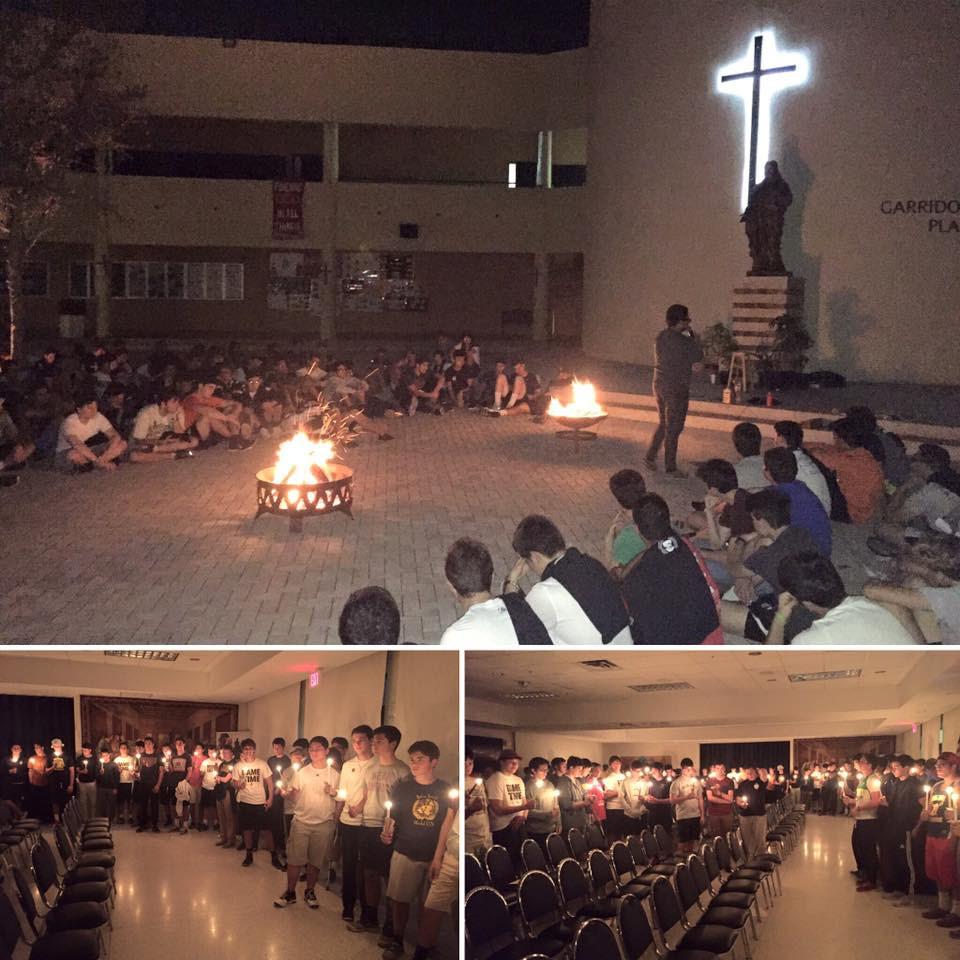
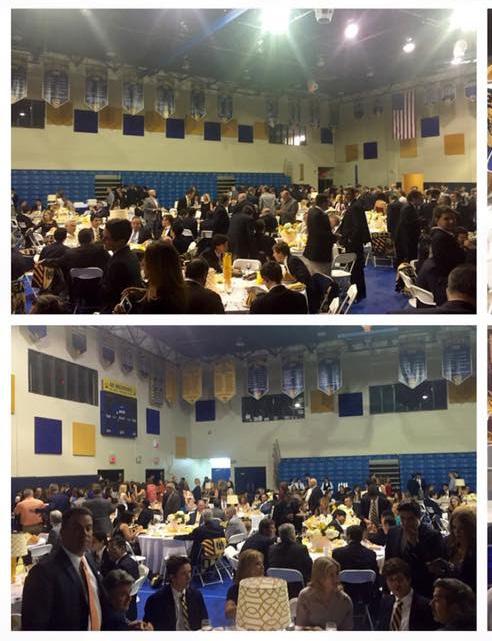
By: Peter Prieto
As the school year drew to a close, the Class of 2016 made their final rounds in the school. Seniors ended their classes after seven long years on April 28th, and that only marks the beginning of the end. In the last months leading up to their June 1st graduation, they had some of the most important activities of their final year.
Grad Bash took place on Friday April 8, and it marked the beginning of the senior activities. Students visited Universal Studios, along with seniors from across the United States. The day at the park began with a pre-party in which students had a chance to listen to music, mingle, and eat before the night ahead of them.
Final exams began, for seniors, on May 2nd and continued through May 13th. The long, stressful weeks eventually came to an end and marked the finality of their career as high school students.
As a celebration of this, the Senior Prom took place on May 13th at the Biltmore Hotel.
A group of thirty-eight seniors also traveled with Dr. John Gustavsen, Mr. Carlos Maza, and Dr. Lucila Espinosa to Peru on the senior trip, a tradition since 2014. This year, the trip was moved from Easter Break so that it could take place as the seniors prepared for graduation. Students visited cities and sites such as Cuzco and Machu Picchu, and it allowed students to experience first hand what they learned about in their Latin American History classes.
“We were very excited to be returning for the third time. Every trip has been an amazing experience. Having this trip closer to the end of the year made for a different experience for the students,” said Dr. Gustavsen.
The Baccalaureate Mass also took place on May 25th, and it was one of the most important mo-


ments in the students’ career at the school. During the Mass, students sat side by side with their mothers who, no doubt, have made sacrifices for their sons throughout the years.
The Alumni Pin Ceremony marked the induction of the Class of 2016 into the Alumni Association. The Association is a family of over seven thousand strong alumni who are willing and open to participate and help the school and it’s students.
Graduation, the final activity for the senior class took place on June 1st. The night began with the procession of students and faculty, followed by a speech from commencement speaker Caesar Conde ‘91.
The Class of 2016 has had a long, memorable path to this, the final ceremony of their high school career.


PROUD TO SUPPORT THE BELEN TRADITION WITH QUALITY UNIFORMS AND SERVICE
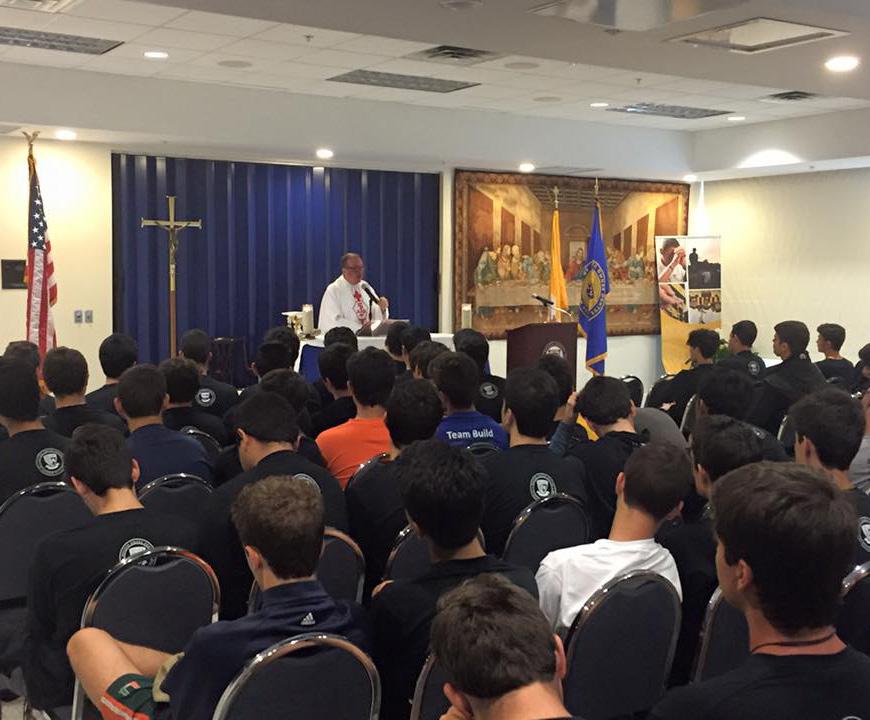
By: Matthew Powell
On March 18th, the seniors gathered in the central patio to begin their last retreat together as Belen Jesuit students. Led by the senior peer ministers, students participated in a variety of activities throughout the weekend that bonded the class as a whole.
To start the event, the seniors gathered for prayer in the central patio before eating dinner and then separating into small groups. In these groups, seniors were asked questions to reflect and share. This activity was, in my opinion, the most pivotal moment of the retreat. It gave students a comfortable setting to open up within a small group and feel safe that what they were sharing would not get passed around to anyone else.
“The small groups gave us an opportunity to grow comfortable before opening up to the larger group,” said senior group leader John Hyland.
The seniors were then led to the Coscuella Hall to listen to student talks and witnesses who made their stories relatable and personable in order for the rest of the members on retreat to tie it back to the topic of
God’s mercy. T
These talks paved the way for a special speaker, Ed Gerety, to speak to our class again. While we were young sixth graders, this man spoke to us, and he was able to come back to speak to us as seniors. His talk centered around motivation, setting goals, and achieving them. He also spoke to us about body language and the way we appear to others.
Retreaters then went back to small groups to discuss the talk, and then headed to the central patio to listen to talks about forgiveness. They were also led by Father Willie in a forgiveness activity where we wrote down names of people who were in need of our forgiveness, and we tossed the paper in a fire. This activity was a perfect transition towards our palancas, as we could be in a state of peace and tranquility while reading heartfelt letters written personally for us.
The night ended with all those in attendance setting up camp in the gym for the night. We then gathered in a circle for the open mic event, where any student could address the class with everyone listening attentive-
ly. This was a very emotional activity that propelled us to the last day of our senior encounter.
The next morning began with a Mass said by Father Willie and an alumnus talk to the group. After, the senior video was shown, showcasing old photos of students of the class, memories from sporting events and senior activities, and several Belen teachers sending a special message to the class. Another open mic ended the retreat, and this was an event that opened the floodgate of tears. We then excitedly went to the Cosucuella Hall to be joined with our dads for lunch.
“It was an emotional ending, and it was nice to come out and see our dads there and enjoy the moment with them,” said senior group leader Luis Mejer.
The event was a huge success, and I hope every single participant received the same emotional effect that I felt while on this retreat.


By: Michael Cairo
Aesthetics is the most neglected field of philosophy. Quite fairly, this is probably because it is the most useless. Our opinions on questions of politics, ethics, and metaphysics affect our lives much more than our convictions on what makes something beautiful or not. Yet, aesthetics has followed philosophy as one of its most minor major branches since its inception. What does it have to do with you, though? Chances are you believe beauty is subjective, cultural, taught, etc., but maybe studying aesthetics may change your convictions and general view on not only the question: what makes something beautiful, but also increase your appreciation of art overall.
To begin, to answer the central question of aesthetics ‘What is beauty?’ with ‘Beauty is subjective’ is insufficient. This would be like asking ‘What is a thorn’ and replying ‘A thorn is sharp.’ Subjectivity, although perhaps a quality of beauty, like sharpness to a thorn, is not exactly what entirely makes beauty. Aesthetics, thus, seeks to define what beauty as a phenomenon is. Truly, there are objects that are beautiful and others that are not, and between these, there are varying degrees of beauty. Aesthetics seeks to qualify what one beautiful object has over a neutral or ugly one. Other realms of aesthetic thought seeks to form opinions about the value of beauty overall. The most controversial assertion
that could be made in the aesthetic field is that beauty is indeed objective. This is to say, that if one was pretentious enough to waste their time watching an opera, there could be qualities to it that make it certainly and truly more beautiful than watching a video of a dissection. If these qualities do exist, then there must be something objective about their presence or not. A good analogy for this is comedy: with some minor variations, it is generally intelligible to most people what is funny and what isn’t. While people’s opinion of who and what’s funny does vary, it generally is recognized that some claims are objectively funny and unfunny. The claim “Our principal secretly hoards feathers to put together a grand falcon costume to unveil at graduation,” is somewhat funnier than “2+2=4.” Similarly, making disruptive noises in class is much funnier than noises made by the teacher. Thus, objectively, there are claims that contain qualities that are objectively funny in disposition, and not. Claims that are dry and objective are not funny in any way, while claims that are flippant and random are. And while many may disagree over what comical claims are funny or not, the fact that they are both recognized as humorous in premise serves testament to the objectivity of comedy. For instance, one may debate wether George Carlin is funnier than Bo Burnham, but no one debates whether
y=mx+b is funnier than pi. In fact the absurdity the latter debate is almost funny because of its absurdity. Similarly, beauty, in an objective way, could be objectively present in somethings and not in others. An opera is, in premise, beautiful while the operations of a meat packing factory are not. The essence of aesthetics is to quantify what qualities these may be. One relevant hypothesis is Francis Hutcheson (a 17 century philosopher who coined aesthetics) who said what makes something beautiful is “variations amidst order.” Coupled with Kant’s hypothesis that things that are beautiful must be purposively beautiful, one could begin to get a grasp of who how general aesthetics hypotheses are. When someone claims objectivity in beauty, chances are they don’t mean to say one painting is objectively more beautiful than others, generally, they’d mean that art itself is generally more beautiful than something utilitarian. All this is turned on its head however, when modern artists attempt to force us to find beauty in things that are objectively not.
Is this an experiment in aesthetics, or just a violation of our human conceptions of beauty? Perhaps this is why some have a stong aversion to modern art.
Northern Trust is proud to support Belen Jesuit Preparatory School. For more than 125 years, we’ve been meeting our clients’ financial needs while nurturing a culture of caring and a commitment to invest in the communities we serve. It’s all part of being a good neighbor.

FOR MORE INFORMATION CONTACT
Alexander Adams
Senior Market Executive Miami-Dade 600 Brickell Avenue, Miami, FL 33131 305-372-1000
northerntrust.com

There I was, in the dead of night, with the wind howling, the thunder crackling, the storm surging, while I investigated the treehouse. The notoriously abandoned treehouse, the one that made rumors spawn amongst the kids at my school about its infamous lethal nights, much like this one. The violent jolt catapulted me across the treehouse, as the structure began to gyrate. The dark sky cleared and the storm subsided as everything culminated and concentrated into the initiative of the moment. Then the whole treehouse began to gyrate, inducing a horrid nausea and fear in my gut that washed over me. Right when I was about to release my tempest tossed dinner, the commotion ceased and the sky relieved from the shocking upheaval of energy. Yet now, instead of the gloomy woods, mountains loomed in the distance and grasslands sprawled the flat valleys. The wonder, awe, and curiosity that I felt overcame my anxiety and fear of this new land. Finally, I stepped into the new world, wondering what challenges and adventures awaited me.
Now this article isn’t a fictitious short story, although the introduction is shaping to be so, but instead about my beginnings as a writer and my perspective on
creative writing’s essence. The introduction is an excerpt from the first story I wrote, when I was six. Obviously, I revised and modified it to fit into the current context and standards of writing, but it still retains the original event. The first story I wrote talked about how I lived with my sister in a house near the woods. There was a treehouse, the one mentioned before, which I investigate and accidentally get transported to a different time period in history. This story was based on the Magic Treehouse book series, in which the same exact plot occurs as the one in my story, except that I don’t bring my sister along on my adventures. Although my first story wasn’t very creative or original, when I took a closer at it in order to write this article, I would find myself looking at a bigger picture, not the complete one, just big enough to tell that fictitious and creative writing is not just about creativity; it’s about formulating, condensing, and expressing heartfelt ideas or topics in any way you can, whether they are original or not, through art or writing or music.
From the moment I began writing the first short story I ever wrote, I started to fall into a tendency of reading more books than my other classmates when it wasn’t required and completing my En-
glish and writing assignments at a faster and easier pace than the others.
While I struggled in math and earned the frustrations of my math teachers as I bothered them with my many questions and difficulties, I excelled at reading and writing and earned the opposite reactions from my English teachers. Although I don’t have many years of experience and am still a developing writer, I have learned the significance of different thinking methods through my successes and failures in the subjects of reading and math. I excel at reading and writing because of my hardwired creative imagination and reasoning that I was born with. On the other hand, I am poor at math because I lack the more systematic rationalizing that factors into my success with the subject. I cannot easily derive an exact solution because my ability to interpret double meanings and the liberty of producing many meanings or solutions out of one scenario gets in the way. Yet, while I am a creative thinker, I recognize that others may think the opposite way and excel at math while struggling in reading. Such a method of thinking cannot be made, only developed and grown, for it is born with you.
For those inclined to pursue writing and English in general, I have discovered for myself the immense value and vitality of reading. Each time I went to write a short story, they always ended up based on a plot from a book that I read, which I then gave it my own spin. The less you read, the more you limit yourself upon writing and upon producing a creative literary work. Not only does reading provide fresh ideas to modify and develop your own taste, but it improves your grammar as you constantly engrave the correct use of grammar upon each page turned.
Ever since I knew what creativity meant, I spared looking for its official definition, so I’ve adopted my own meaning of the word. That being said, the formal meaning of creativity is the use of the imagination or original ideas, especially in the production of an artistic work. Now, even though I respect that proper definition, I wield my own perspective on creativity. I believe that creativity is not necessarily
about original ideas, for my own stories have not been completely original or unprecedented, but instead, they demonstrate my own twist or take on a common or classical concept. Genuine originality depends on the way someone takes anything in life and hallmarks their own style while still keeping within the boundaries of their basic topic. That is what truly separates an artist from the rest.
Yet after all I explained to you about what I believe is truly authentic about creativity, if you just finish reading this piece and take upon yourself that real creativity is what I think it is, then you have missed the whole point about creativity. Creativity is about your imagination, a world of your thoughts and opinions, not mine. Moreover, when I explained what I thought defined creativity, I used the word perspective because creativity is about the way you express your point of view through fictitious compositions that numerous
times include only unique language and events of deep meaning to reveal your opinion and style. So with that in mind, returning to the first paragraph of the article where I stopped at a cliffhanger as I was about to step into the new world, I was going to choose to step into the world of dinosaurs. But as a testimony to what I believe is the authenticity of creativity, to you I might be entering another place or time, and to someone else the outcome will vary as well, but at the end of the day it all comes down to the individual liberty of creativity, and not the cohesive and popular restriction of it, the root that anchors creativity to its beautiful uniqueness, diversity and variation.


It’s a wall
A divide
It drives a dream away from your cradle
Holding it all together
When it just seems to fall apart
Humanity’s worst enemy
Our greatest fears
Our passions disappeared
Our love
Now a fleeting dove
Doors are shut
We are left in our own darkness
The only thing left to see
Is the reflection of our own soul
In the mirror we wake up to every morn-
ing
Roads now blocked
Roads now changing
The directions remain
Fear. Sorrow. Regret. Guilt. Failure. Shackles lock our will
Cages imprison our mind
Our free soul now trapped
With doors now closed
Until a world renewed
A dead end revealing
A divide now bridging
A new road providing New directions are guiding
Hope. Determination. Perseverance. Diligence.
But mostly love
A love undying
A love unstoppable
A love undenied
A love now surging
A broken will revived
A defeated mind was tried
Renewed soul alive
Free passions arise
Doors are closed
Hidden doors now shown
A new world to explore
A triumphant soul
Is the only reflection to be seen
A battle lost, a war won
A battered heart, a iron wall Undying love, adversity cast away By a power tested
A struggling spirit
Unleashed
An angel victorious
For only certain individuals
For only the best
For only those who willed themselves
Forward into despair
Those are the spirits
Great
The spirits
Mighty
The spirits
Joyful
Those who have shed the most tears Smile the brightest
Those who have seen the most failure
Succeed in the grandest manner
No one who’s story was told
From a path full of open doors
Was ever able to tell the story of doors
hidden The doors that were most difficult to see
Are only seen by those whose hardship
Has shown them a paradise unknown
And a world to love
When you’re not here
My heart’s invisible tears
Trickle down the sides
Of its soft beating cheeks
Time spent with you gone
Is like time stretched too long
And my soul cries your name
Longing for its missing companion
When I’m alone
Your name strikes a tone
So melodic, so soft
And thoughts of you flood my mind
I’ll feel out of place at best
Much like seeing a bird’s nest But missing a mother
To give warmth to its eggs
When you’re missing, the pain feels like a kiss in the rain
Without rain
Without a kiss
Because without you
I’m cast from eternal bliss
The Eden of my heart
In you lies my purpose to live

Miami Auxiliary Bishop Peter Baldacchino blessed the grounds where the Gian Zumpano Aquatic Center & the Peter John and Gabriel Jimenez Pool at the aquatic center will be built. Jesuit Father Guillermo García-Tuñón, Belen’s president, thanked the donors as well as the invited guests.
“It is the leadership, vision, and financial support of the Zumpano family which has steered this incredibly important project through a series of challenges and delays over the years that has led us to this moment,” said Father GarcíaTuñón.
from the class of 1986. This is an emotional day for Gian’s brothers - Joey ’87, Danny, Carlos, Lucas ’18 and Noah ’23 - who all attended or will soon attend Belen, because we are celebrating the legacy of an individual who was a true man for others.” Gian, was the Salutatorian of his class and passed away at the age of 22. During his time at Belen Jesuit and beyond, he inspired others through his humility and selflessness. The presence of his bust on the pool deck will serve as a lasting reminder of his contagious spirit and dedication to teaching young children to swim.
“For Peter and Yamile Jimenez and their family, the Belen Jesuit experience began in 2003,” said García-Tuñón. “Their oldest son, Peter John distinguished himself as an outstanding student and leader within the class of 2010. The youngest and most energetic member of the Jimenez family, Gabriel, started at Belen in 2009. Known for his love for Belen and charisma, he will graduate in a few weeks as a two-time state champion in Water Polo. Peter and Yamile have been very actively involved during their sons’ time at Belen. They are looked upon as leaders in this community by the faculty and parents alike, and Yamile is an active member of the school’s Board of Advisors. The pool that will be named for their sons.”
The new aquatic center will feature a state-of-the-art Olympic sized pool and be home to the championship-winning swimming, diving, and water polo teams. The estimated date of completion for the project is the summer of 2017. John Medina, from the class of 1977, is the architect.

By: Antonio Valencia
As the rest of the school sauntered through their last month of school, the seniors faced the end of their high school careers. With nearly the entire month of May between their last day and their graduation, the class of 2016 took the first step towards the rest of their lives on June 1st, their graduation day. It’s what many seniors had been preparing for in their nearly seven years at Belen. It was a great and long journey, but the ride is over and the destination in sight is college.
The Class of 2016, like all the classes before it, is aspiring for greatness. For many, this greatness has been shown through their academic and athletic feats. As a result, the class of 2016 boasts a variety of impressive collage admissions and acceptances. From New York to California, they aimed far and wide to pursue their educations.
Due to their amazing reputation and esteem, the Ivy League colleges are universities that our school is proud to have had the Class of 2016 accepted into. Among

many universities, a handful of students from the Class of 2016 have been accepted into Ivy League schools like Cornell, Princeton, Columbia, U Penn, and even Yale and Harvard. Many of those accepted plan on attending these prestigious universities.
“I’m really happy I am able to attend such a great school,” said senior Alexander Alepuz, who will attend Cornell University.
In addition to the Ivy League colleges, there are numerous students attending other prestigious private and state institutions, including colleges like John Hopkins, Carnegie Mellon, Penn State, and U Chicago, just to name a few. These schools. and many more, are among some of the highest rated in the country, and they will certainly allow for further educational growth for the Class of 2016.
For students staying in-state, our home state of Florida also offers a variety of highly ranked schools. Many students applied to the major Florida schools like UF, FSU, UM, and FIU, and many students are
attending said institutions. These schools offer an excellent education, while at the same time being cost efficient. State and public schools like FSU offer reduced tuition for Florida residents, substantially reducing the tuition.
Many students also receive benefits from the Florida Prepaid Program, offering yet another incentive to stay in-state. Some students have decided to stay in-state to benefit from this low tuition, as going out-of-state for school can often be expensive, whether it be tuition or cost of living.
“I plan on attending Miami Dade College, and then transfer to UF. It’s cheaper than going out-of-state,” said senior Gabriel Tozo.
Wherever the class of 2016 ends up, one thing is certain: they will continue to strive for excellence in all that they do. No matter where they are, the Class of 2016 will share that same bond that every other class before them shares as well: their time here at our school.
Adelphi University
The University of Alabama
American University
Anna Maria College
Auburn University
Austin College
Babson College
Barry University
Baylor University
Becker College
Beloit College
Bentley University
Boston College
Boston University
Bowdoin College
Brandeis University
California Institute of Technology
University of California, Berkeley
University of California, Los Angeles
University of California, San Diego
Canisius College
Carnegie Mellon University
Case Western Reserve University
The Catholic University of America
Central College
University of Central Florida
University of Chicago
University of Cincinnati
Claremont McKenna College
Clark University
Clarkson University
Clemson University
University of Colorado at Boulder
Columbia College Chicago
Columbia University
Cornell University
Curry College
University of Dallas
Dartmouth College
University of Delaware
DePaul University
DigiPen Institute of Technology
Dowling College
Drexel University
Duke University
Elon University
Embry-Riddle Aeronautical University
Emerson College
Emory University
Fairfield University
Flagler College
Florida Gulf Coast University
Florida Institute of Technology
Florida International University
Florida Polytechnic University
Florida State University
University of Florida
Fordham University
Franciscan University of Steubenville
Full Sail University
Geneva College
The George Washington University
Georgetown University
Georgia Institute of Technology
Georgia Southern University
The University of Georgia
Georgian Court University
Gonzaga University
Goucher College
Harvard University
Hobart and William Smith Colleges
Hofstra University
Holy Cross College
College of the Holy Cross
Hult International Business School in San
Francisco and London
University of Idaho
University of Illinois at Chicago
University of Illinois at Urbana-Champaign
Indiana University at Bloomington
Jacksonville University
John Carroll University
Johns Hopkins University
University of Kansas
Lehigh University
Lipscomb University
Louisiana State University
University of Louisiana, Lafayette
Loyola Marymount University
Loyola University Chicago
Loyola University Maryland
Loyola University New Orleans
Lynn University
Malone University
Marquette University
University of Maryland, College Park
Methodist University
Miami Dade College - includes Honors College enrollment
Miami University, Oxford
University of Miami
Michigan State University
University of Michigan
Morehouse College
New College of Florida
New York University
The University of North Carolina at Chapel
Hill
North Carolina State University
Northeastern University
Northwestern University
University of Notre Dame
Oglethorpe University
Pennsylvania State University
University of Pennsylvania
Pine Manor College
University of Pittsburgh
University of Portland
Pratt Institute
Princeton University
Purdue University
Regis University
Rensselaer Polytechnic Institute
Rhode Island School of Design
Rice University
University of Richmond
Rider University
Rollins College
Saint Joseph’s University
Saint Louis University
San Diego State University
University of San Francisco
Santa Fe College
Savannah College of Art and Design
Seton Hall University
University of South Carolina
University of South Florida, Tampa
University of South Florida, St. Pete
University of Southern California
Southern Methodist University
Spring Hill College
St. John Fisher College
St. Thomas University
University of St. Thomas
Stanford University
Stetson University
Suffolk University
SUNY College of Environmental Science and Forestry
Syracuse University
The University of Tampa
University of Tennessee, Knoxville
Texas A&M University
Texas Christian University
The University of Texas, Austin
The Ohio State University
Trinity College
Tufts University
Tulane University
Union College
Vanderbilt University
University of Vermont
Villanova University
Virginia Institute of Technology
University of Virginia
Wake Forest University
Washington College
Washington University in St. Louis
University of West Florida
Westminster College
Wheeling Jesuit University
College of William and Mary
University of Wisconsin, Madison
Worcester Polytechnic Institute
Xavier University
Yale University

Looking back at my seven years at Belen, I am glad to say I leave with little to no regrets. My senior year has been filled with bittersweet emotions, ranging from all the sporting events to the variety of senior activities planned for us. It truly has been a blessing and an honor to be a member of the Class of 2016, and the memories I have made with the many different people that make up this institution will be eternal.
I joined the Vincam staff sophomore year, excited to write about sports. Although I was not published until junior year, I learned the ins and out of how to produce a well written and coherent article, in all different genres including editorials, news stories, features, and sports. Sophomore year helped me open my horizons on the topics I wished to cover, and none of this would have been possible without the guidance of Mrs. De Aguiar. She has helped me and the other editors along the way, finding us new topics of interest, or developing a new angle on a interesting or controversial story. She has always been a source of encouragement and inspiration, and I am extremely thankful for all the help she has given me over the past three years.
Being named Editor-In-Chief was one of the most exciting privileges bestowed upon me in my Belen career, and it carried a mountain of responsibility. Working under Michael Perez and Joshua Barditch in the years past, I was able to learn how to run the newsroom in a fun and exciting way, while keeping the editors engaged, on task, and willing to help with anything from designing layouts to making edits on stories.
The success that Vincam has had over the past year would not have happened without the help and dedication of my right hand man, Daniel Portuondo. Mrs. De Aguiar has described our relationship like an old married couple, and I have come to realize that this comparison is fairly accurate. Porty and I are always disagreeing on small details, and we always jokingly quarrel about each other’s design and writing skills. All jokes aside, his behind-the-scenes work of laying down the stories, inputting ads, and doing all the tedious work that goes with publishing a well designed paper was essential. His work and the work of this group have made my job easy, and I will miss the memories we have created in fifth period.
I have thoroughly enjoyed every last second of this year and my newspaper team. Although it is extremely sad to see my tenure as a Belen Jesuit student come to a close, my time spent at this school has been crucial to the development of myself as a person, and I will be forever grateful to every second spent here.
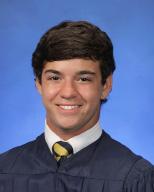
The boy walking into Belen Jesuit in 2009 was still disappointed that he’d have to deal with another seven years of school. He’d received the boundless lectures of the importance of getting good grades and learned the extent of Belen’s influence on the Coca-Cola empire, having had an alumni as its president. However, that boy walked in without any concept of the future. He didn’t know colleges past the vague idea of what Harvard was. He didn’t know the essentials of a good resume, or the diverse fields of academics he’d be exposed to. Growing up an only child, his idea of brotherhood was exclusively by definition at best. The only thing he knew about who he would be was his passion for writing.
Every passing grade instilled lessons in me that I’d never forget and strengthened my bond with those who studied beside me. From my point of view, I was convinced this was going to be the experience that is so stereotypically jammed into pop culture. Those who played sports were guaranteed to have low IQ’s while those antisocial nerds made up for their lack of athletic affinity in the classroom, and these jocks were the bane of the nerds’ existence. As it turned out, Belen was in no way what I expected. Sixth grade was a new environment for the class, and admittedly, some us resorted to a lesser version of these stereotypes to find a sense of comfort and predictability. With each passing year, however, we as a whole abandoned this idea of a sitcom high school. These concepts of popular versus unpopular never came into fruition in my experience at Belen. It was this environment that encouraged me to join the football team, which engraved essential virtues that I am not sure I’d ever have learned anywhere else. While the classroom taught me honesty, integrity, and intellectual curiosity, the field taught me determination, courage, and the importance of sacrifice. I have found that through the trials at Belen, whether academically or athletically, every struggle further solidified the bond between me and my classmates. The bonds that were constructed morphed into friendships, which then transformed into brotherhood.
It is this fact that through success or struggle, I gained something that furthered the school’s mission of transforming us into young men that encompass all aspects of the Cura Personalis. It also through Belen that I made my passions concrete. I discovered my love for journalism here in the Vincam, and reinforced my acuity in creative writing through my English teachers who were always eager to read my stories and never feared to present criticism where it was needed and praise where it was merited. This is why writing the word “goodbye” plunges my heart and fills it with dread. I must leave behind the second home I’ve found in this school, but regardless of how many goodbyes I must say by June 1st, I find solace in the fact that whenever a looming sense of homesickness strikes, I can return to Belen Jesuit Preparatory School and be accepted with open arms.
Writing in the first person is something I have taken for granted. This, my farewell column, is likely one of the last things I will turn in that is written this way. As I take it all in, I have a few things to say. The past seven years at this school have been phenomenal; every person at this school has made this experience better. Each teacher I have had has taught me so much. I made mistakes, and I learned my lessons. Belen truly gave me the best experience I could’ve had in high school. The bonds made throughout the seven years are thicker than blood, and everyone cares for one another.
Some of my favorite memories have stemmed from writing for the Vincam, Belen’s Official Student Publication. The staff has been outstanding, and they add to the excitement of writing for the paper. With Mrs. De Aguiar at the helm, we did our best to provide the school with articles we deemed pertinent to the student body, young and old. Deadlines were met, some were not. We had time for fun, but we knew that work came first. The last thing I want to say is the most important. I just want to say thanks, to those who have read the articles: without you, there would not be a paper. The Vincam staff is fueled by the desire to write. It was created to provide the students of Belen Jesuit with a voice. This was time well spent, and if I had to go back and fill out the course selection sheet over again, I’d make the same choice. So, thanks.

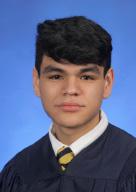
Since I first started this school in the sixth grade, I have had the fortune of being able to take part in a variety of classes. I’ll be the first to admit that there were a lot I really didn’t care for, mostly because I deemed them unimportant to me in the grand scheme of things. Being part of the Vincam, however, is not one of these classes. Having been a part of this program since tenth grade, it is a understatement to say I will miss it. It has been a blast being able to take part in the process of making a paper, especially with such a small group. Some of my fondest memories were had in the newsroom, laying down stories or editing articles. My experiences in this class will help me succeed in the future, through the lessons and skills I learned. Being part of the paper has taught me the value of team work, and the importance of contributing to greater good. While some stories may not be as interesting or impactful, they are all part of the bigger picture, forming the paper. I would like to thank our editors in chief, Matthew Powell and Daniel Portuondo for the hard work they put into every issue. Without them, I’m not sure how the paper would have been made. I would also like to thank our advisor, Mrs. DeAguiar, for aiding us throughout the process. I wish the best for the program in the future, and I can only hope the Vincam will continue to strive for journalistic excellence.
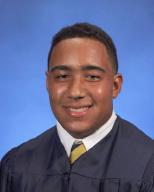
My name is Max Fernandez, and I am senior from the graduating class of 2016. It has been a long and crazy journey that has been going on since the sixth grade. I, like many others, was thrown into a new school and environment coming to Belen at a young age. It was very hard adjusting to my new life. I knew no one and knew very little about the school. I still remember the days when finding my classroom and getting there on time was a struggle. Belen works in a weird way, sixth grade and twelfth grade are the two extremes, with sixth graders working their hardest to run to class to get there on time, scared of most teachers, and scared to get in trouble. But in the twelfth grade, it is the opposite. Seniors think they know more than the rules and are not scared of anything. The thing sixth and twelfth graders do have in common is the uncertainty about their futures. One constant for me at Belen was football. I have played football for Belen since the seventh grade, and football made me who I am today. Life at Belen without football is unimaginable. Thanks to my coaches and teammates, I will forever treasure my time at Belen, and yes, the backto-back football district championships. Belen was a great choice, and I am glad I made the decision to attend Belen Jesuit back in sixth grade. As I stare into the uncertainty of college life, I feel forever grateful for all the things Belen has done for me and taught me. I know that all the friendships I have made at Belen will last a lifetime. I will always be a part of the Belen family and will ridiculously miss being a class of 2016 student athlete at Belen Jesuit Preparatory School. Thank you.
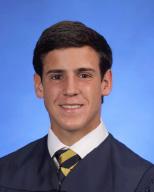
I can’t believe that my seven years at Belen are coming to an end. It has been a wonderful and fulfilling experience. I would like to express my gratitude for everyone that has helped me get to where I am today. Personally, I would like to thank Mrs. De Aguiar who has helped me grow as an individual, whether in Vincam or as my teacher in my sixth grade reading class. Also, I would like to thank her for helping me become a better writer every year. I would also like to thank all my co-editors in Vincam. The Belen newspaper has been a very rewarding experience. I started Vincam sophomore year and do not regret my decision. I recommend this class to anyone who is interested in writing. As I conclude, I would like to thank the Belen community for making Belen one of the best experiences in my life.

As my last days come upon me, I’m facing the fact that my seven-year tenure at Belen is coming to an end. My three years that I dedicated to the Vincam is ending. It was truly an honor to write for the school newspaper. I want to first thank all my classmates, who I can truly call brothers, and Mrs. De Aguiar for helping me throughout my time here. It feels just like the other day I was a sophomore preparing myself to be a part of this group. Although not a popular elective amongst my peers, I chose an elective that I wasn’t too sure of what to expect. I didn’t know what I was enlisting myself into. Thankfully, it was probably one of the best choices of my Belen career. I matured as a writer and as a man throughout my years in Vincam. I’ve seen the Vincam and my peers transform throughout my years. Writing stories, meeting deadlines, laying down, and designing have been a part of my life since my sophomore year. These past years have been some of my best, and they will forever be in my memory. I wish my fellow classmates and the future Vincam staff luck. The Vincam always challenged me and taught me valuable lessons that I wouldn’t trade for anything.
